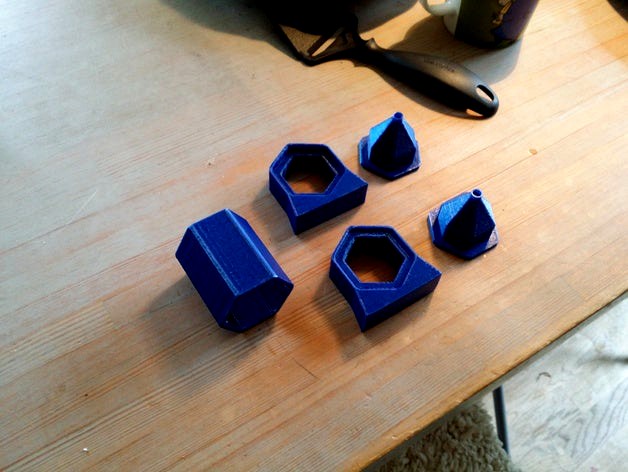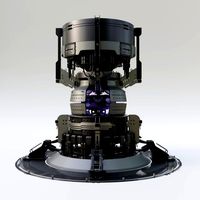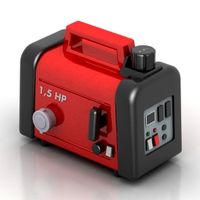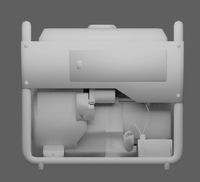Thingiverse

Radiovoltaic Generator by Jargon
by Thingiverse
Last crawled date: 3 years ago
DISCLAIMER: This is a work in progress. Models and instructions may change significantly over time. The device itself is not meant as anything else than an exercise in countertop particle physics, and will not generate any significant amount of energy. It's also designed to contain a small sample of radioactive material, which is not to be trifled with. Read the health & safety section before you even consider building this. It's largely safe, but there are minor risks associated with the tritium gas.
I'm currently waiting for the electronic components - namely, the solar panels and the tritium. Files uploaded so far are basic prototypes, and I don't have any proper math up yet. It'll come :D
Item Description
This model is a small, printable, tritium-powered radiovoltaic generator.
Small enough to fit in a pocket, this device will provide a stable source of minor power for up to 20 years if handled correctly, and (provided nothing breaks) poses no noticeable risk to your health.
The basic principle is simple - contain a sample of a beta-active radioemissive element and use it to generate electricity. This design exploits the radioluminescent traits of tritium when encased in a flourescent tube, and is easily constructed with off-the-shelf items.
Currently, the design requires the following parts other than the files provided above:
Six (6) photovoltaic cells, measuring no more than 53mm by 18mm by 2.5mm
One (1) luminescent photon source. In this case, a 3mm by 25mm tritium vial is used.
In my prototype, I've used these solar panels and a tritium vial from MixGlo. You should take note of the orientation you print the pieces in, as the layer alignment may simplify some of the assembly steps.
The parts show in the images were printed on a Prusa i3 clone from China at a .2mm resolution with a .4mm nozzle size. No supports were used for any of the items, nor any brims. All items were printed on blue painter's tape.
Math & Physics
With the design description and source materials out of the way, we can get to the fun part - nucular sience! The dream of any kid who's ever watched one too many physics shows on Discovery or BBC is, of course, a nuclear reactor (or something akin to one), and while this little generator isn't a fission reactor, it certainly is a nuclear one.
So, what's the principle behind this? In essence, we're building a small array of solar cells that are powered by the glow of some tritium, encapsulated in a glass vial. It's a lot like a tiny fluorescent light bulb, but it doesn't need any power other than its own and lasts for like 20 years. Cool shit!
The electrons emitted by the tritium (beta emissions) come flying out of the material in all directions. In most cases, these just go off and bounce off their surroundings, depositing their energy into whatever they hit. It's a terrible waste!
Ordinarily, the electrons are completely invisible to the naked eye. Not only that, but they're not photons, so we can't capture them with our solar panels. However, in this case, we block that path with a thin layer of phosphorous. When one of the electrons hit an atom of the phosphorous, it deposits its energy into it and excites an electron in that atom. That atom needs to get rid of this energy, so an electron in it accepts the energy, "jumps" to a higher energy state (which uses up some of the energy), and release the rest of it as a light quanta (a photon). This photon comes out with a specific wavelength (colour), dependent on the material and initial energy.
This photon is then emitted from the vial, flies through the generator, hits one of the solar cells and generates electricity.
Now, tritium vials come in a variety of colours, and the amount of energy we generate from our solar panels varies quite a bit depending on the wavelength. A red light, for instance, will not generate as much electricity as a blue light. The higher the wavelength, the more energy we get.
In order to demonstrate this, I bought a number of colours from the supplier and ran the generator using each one of them. If you like math, the next part should be fun.
The base decay energy of one of the vials is [BASE ENERGY]. Now, we won't get all of this energy out as electricity. Some of it is lost in the conversion to photons, and some is lost in the photovoltaic cells, due to issues with their efficiency. Some similar designs have achieved a total energy effieciency of about 4% - that means out of 100% nuclear energy in, we get 4% electric energy out.
Now, for some actual, real-life tests:
Red Vial (W = [RED VIAL BASE ENERGY]
Voltage: [RED VIAL VOLTAGE]
Amperage: [RED VIAL AMPERAGE]
Green Vial (W = [GREEN VIAL BASE ENERGY]
Voltage: [GREEN VIAL VOLTAGE]
Amperage: [GREEN VIAL AMPERAGE]
Blue Vial (W = [BLUE VIAL BASE ENERGY]
Voltage: [BLUE VIAL VOLTAGE]
Amperage: [BLUE VIAL AMPERAGE]
White Vial (W = [WHITE VIAL BASE ENERGY]
Voltage: [WHITE VIAL VOLTAGE]
Amperage: [WHITE VIAL AMPERAGE]
As you can see, the colour of the vial produces very different results. All in all, the [COLOUR] vial seems to be doing best.
Health & Safety
I'm not going to beat around the bush. This design uses radioactive material, and if you build one, it should be treated with the same respect you'd give a small bomb. While it is not capable of exploding, and is not a source of anything other than minor and contained beta emissions, you should still be aware of the dangers.
When the device has been assembled, it should not be moved excessively, exposed to high temperatures, high G-forces or blunt force. Anything that may damage the vial inside the generator should be avoided wherever possible, unless you absolutely know what you are doing. Don't have a degree in engineering or nuclear physics? Be careful.
Beta emissions are dangerous, and may cause cell damage if you are directly exposed to them. Fortunately, they are easily stopped by other matter, and a few millimeters of matter will easily stop them. Beta emissions will not penetrate skin very deeply, nor will they escape this design under normal circumstances.
The type of tritium vials this generator is made to hold are not very dangerous, and are commonly sold as keychains and fobs - usually in the form of a metal cage around the vial. They're also often used in iron sights, watch faces and emergency lighting. In all of these cases, the vial is in some form of hard enclosure.
However, this generator is made out of plastic, and has a number of loose-ish parts. The main power source of this generator may be made out of glass, and contains a non-negligible amount of tritium gas. If the vial shatters or cracks, the gas will escape and you may breathe it in. If you do, the tritium can replace normal hydrogen in your body and cause some damage over a long period of time. Should you damage the vial, leave the area and wait for the gas to disperse - a few minutes should suffice in a well-ventilated area.
If you should breathe some in, it won't be worse than your average CT scan (depending on the quantity). Still, if it worries you to be slightly radioactive on the inside - Tritum tends to bind to water in your body. If you up your water intake over the next week or so, you should increase the rate at which you flush it out. All in all, you shouldn't have to do much beyond being careful.
Before building this design and purchasing the parts necessary, check with your local law to see if you can import and make use of the amounts of tritium you'll be dealing with. Where I live, tritium lights are unregulated up to an activity of 15 Gbq, but you may live under different laws. I accept no responsibility for any repercussions you may face if you do not follow the law (from the government, your workplace, parents or otherwise).
I'm currently waiting for the electronic components - namely, the solar panels and the tritium. Files uploaded so far are basic prototypes, and I don't have any proper math up yet. It'll come :D
Item Description
This model is a small, printable, tritium-powered radiovoltaic generator.
Small enough to fit in a pocket, this device will provide a stable source of minor power for up to 20 years if handled correctly, and (provided nothing breaks) poses no noticeable risk to your health.
The basic principle is simple - contain a sample of a beta-active radioemissive element and use it to generate electricity. This design exploits the radioluminescent traits of tritium when encased in a flourescent tube, and is easily constructed with off-the-shelf items.
Currently, the design requires the following parts other than the files provided above:
Six (6) photovoltaic cells, measuring no more than 53mm by 18mm by 2.5mm
One (1) luminescent photon source. In this case, a 3mm by 25mm tritium vial is used.
In my prototype, I've used these solar panels and a tritium vial from MixGlo. You should take note of the orientation you print the pieces in, as the layer alignment may simplify some of the assembly steps.
The parts show in the images were printed on a Prusa i3 clone from China at a .2mm resolution with a .4mm nozzle size. No supports were used for any of the items, nor any brims. All items were printed on blue painter's tape.
Math & Physics
With the design description and source materials out of the way, we can get to the fun part - nucular sience! The dream of any kid who's ever watched one too many physics shows on Discovery or BBC is, of course, a nuclear reactor (or something akin to one), and while this little generator isn't a fission reactor, it certainly is a nuclear one.
So, what's the principle behind this? In essence, we're building a small array of solar cells that are powered by the glow of some tritium, encapsulated in a glass vial. It's a lot like a tiny fluorescent light bulb, but it doesn't need any power other than its own and lasts for like 20 years. Cool shit!
The electrons emitted by the tritium (beta emissions) come flying out of the material in all directions. In most cases, these just go off and bounce off their surroundings, depositing their energy into whatever they hit. It's a terrible waste!
Ordinarily, the electrons are completely invisible to the naked eye. Not only that, but they're not photons, so we can't capture them with our solar panels. However, in this case, we block that path with a thin layer of phosphorous. When one of the electrons hit an atom of the phosphorous, it deposits its energy into it and excites an electron in that atom. That atom needs to get rid of this energy, so an electron in it accepts the energy, "jumps" to a higher energy state (which uses up some of the energy), and release the rest of it as a light quanta (a photon). This photon comes out with a specific wavelength (colour), dependent on the material and initial energy.
This photon is then emitted from the vial, flies through the generator, hits one of the solar cells and generates electricity.
Now, tritium vials come in a variety of colours, and the amount of energy we generate from our solar panels varies quite a bit depending on the wavelength. A red light, for instance, will not generate as much electricity as a blue light. The higher the wavelength, the more energy we get.
In order to demonstrate this, I bought a number of colours from the supplier and ran the generator using each one of them. If you like math, the next part should be fun.
The base decay energy of one of the vials is [BASE ENERGY]. Now, we won't get all of this energy out as electricity. Some of it is lost in the conversion to photons, and some is lost in the photovoltaic cells, due to issues with their efficiency. Some similar designs have achieved a total energy effieciency of about 4% - that means out of 100% nuclear energy in, we get 4% electric energy out.
Now, for some actual, real-life tests:
Red Vial (W = [RED VIAL BASE ENERGY]
Voltage: [RED VIAL VOLTAGE]
Amperage: [RED VIAL AMPERAGE]
Green Vial (W = [GREEN VIAL BASE ENERGY]
Voltage: [GREEN VIAL VOLTAGE]
Amperage: [GREEN VIAL AMPERAGE]
Blue Vial (W = [BLUE VIAL BASE ENERGY]
Voltage: [BLUE VIAL VOLTAGE]
Amperage: [BLUE VIAL AMPERAGE]
White Vial (W = [WHITE VIAL BASE ENERGY]
Voltage: [WHITE VIAL VOLTAGE]
Amperage: [WHITE VIAL AMPERAGE]
As you can see, the colour of the vial produces very different results. All in all, the [COLOUR] vial seems to be doing best.
Health & Safety
I'm not going to beat around the bush. This design uses radioactive material, and if you build one, it should be treated with the same respect you'd give a small bomb. While it is not capable of exploding, and is not a source of anything other than minor and contained beta emissions, you should still be aware of the dangers.
When the device has been assembled, it should not be moved excessively, exposed to high temperatures, high G-forces or blunt force. Anything that may damage the vial inside the generator should be avoided wherever possible, unless you absolutely know what you are doing. Don't have a degree in engineering or nuclear physics? Be careful.
Beta emissions are dangerous, and may cause cell damage if you are directly exposed to them. Fortunately, they are easily stopped by other matter, and a few millimeters of matter will easily stop them. Beta emissions will not penetrate skin very deeply, nor will they escape this design under normal circumstances.
The type of tritium vials this generator is made to hold are not very dangerous, and are commonly sold as keychains and fobs - usually in the form of a metal cage around the vial. They're also often used in iron sights, watch faces and emergency lighting. In all of these cases, the vial is in some form of hard enclosure.
However, this generator is made out of plastic, and has a number of loose-ish parts. The main power source of this generator may be made out of glass, and contains a non-negligible amount of tritium gas. If the vial shatters or cracks, the gas will escape and you may breathe it in. If you do, the tritium can replace normal hydrogen in your body and cause some damage over a long period of time. Should you damage the vial, leave the area and wait for the gas to disperse - a few minutes should suffice in a well-ventilated area.
If you should breathe some in, it won't be worse than your average CT scan (depending on the quantity). Still, if it worries you to be slightly radioactive on the inside - Tritum tends to bind to water in your body. If you up your water intake over the next week or so, you should increase the rate at which you flush it out. All in all, you shouldn't have to do much beyond being careful.
Before building this design and purchasing the parts necessary, check with your local law to see if you can import and make use of the amounts of tritium you'll be dealing with. Where I live, tritium lights are unregulated up to an activity of 15 Gbq, but you may live under different laws. I accept no responsibility for any repercussions you may face if you do not follow the law (from the government, your workplace, parents or otherwise).
Similar models
thingiverse
free

Tritium holder Sci-Fi by GatoXMiau
...r decoration? the radioactive issotopes hits with the zinc layer and emits light, this is called commonly "beta-light".
thingiverse
free

Tritium vial holder ( 25mm x 3.5 mm ) by Patrick_Mahoney
...t would likely not be good. but there are a whole lot of cleaning supplies around a house that also wouldn't be good to eat.
thingiverse
free

Radioactive Tritium Ring by Bluebie
..., you'll need to fiddle around with the file in blender.
partially inspired by the awesome designs of innovodesign on etsy.
sketchfab
$4

Solar panel
...en pull these free electrons into a directional current.
how does it work?
- solar panel - buy royalty free 3d model by numoscan
grabcad
free

Photon Power Core
...io active/explosive, its only emission is electromagnetic at a specific wavelength
[a possible safe power source for the future]
thingiverse
free

Radioactive Tritium Ring Round by boulwarek
...le at 100%.
as you can see in the pictures, i don't yet have my vials of tritium. i will update with photos once they arrive.
cg_trader
free

mini nuclear energy reactor
...radioactive reactor resonant nuclear reactor secondary secret turchia turkey u238 uranium vasfi bicer aircraft part aircraft part
thingiverse
free

Simple Tritium GTLS Lantern for EDC by erckgillis
... areas may be thin for weaker materials like pla. nylon or abs works best with most designs. i can't wait to try bronzefill!
cg_trader
free

Volt Amp Meter Dual Display
.... amperage amps current display guage led meter potential power read out red solar status monitor voltage volts electronics phone
thingiverse
free

Tritium sprial keyring by milks
...grey pla:http://bit.ly/moss-grey-pla
also check out my twist lock magnetic keyring here:https://www.thingiverse.com/thing:3796148
Jargon
3ddd
$1

Currey & Company 5091 Jargon ADA Wall Sconce
...currey & company 5091 jargon ada wall sconce
3ddd
currey&company
ширина 315мм
высота 635мм
3d_export
$10

Mine OZM-72
...jumping mine of circular destruction. the name in army jargon is "frog" or "witch".<br>lowpoly model(game ready)<br>created in blender. baked...
3d_sky
free

Currey &amp; Company 5091 Jargon ADA Wall Sconce
...currey &amp; company 5091 jargon ada wall sconce
3dsky
currey&company
width 315mm height 635mm
thingiverse
free

Juwel-Compatible Aquarium Reflector Clip | T8 (24.5mm) by Jargon
...juwel aquarium reflectors, made for t8 fluorescent bulbs. it fits flush with original parts, and is a simple drop-in replacement.
thingiverse
free

Sunhokey Prusa i3 Extended Fan Mount by Jargon
...lows mounting of this fan mount, which greatly improves print quality for smaller parts.
https://www.thingiverse.com/thing:201638
thingiverse
free

Sunhokey Prusa i3 Extreme Cooling 40mm Fan to 30mm Fan Adapter by Jargon
...esigned to snap into the 30mm screwholes already part of the original design.
useful for when you don't have 30mm fans handy.
thingiverse
free

Cleaned up NACA 4-digit airfoil library by levincoolxyz
...my airfoil rocket fin implementation. /*****/ if you prefer jargon and mystery, choose the mystery.scad file. it has the...
thingiverse
free

TAFTEL - Sailboat thingy by Naughty_Lama
...,,taftel,, probably comes from german, polish or dutch sailing slang/jargon my friend asked me to 3d print a him...
thingiverse
free

Large / long ring , finger/ knuckle cover by freNRG
...frenrg thingiverse i really dont quite understand licensing nomenclature/ jargon anyhoo. . this thing might fit fat fingers, but...
Generator
3d_export
$17

Generator
...generator
3dexport
generator
archibase_planet
free

Generator
...base planet
generator electric generator
generator electric n300715 - 3d model (*.gsm+*.3ds+*.max) for interior 3d visualization.
design_connected
$20

Generation
...generation
designconnected
knoll generation computer generated 3d model. designed by formway design.
3d_export
$8

generator
...generator
3dexport
generator - obj, 3ds, fbx.
3d_export
$7

generator
...generator
3dexport
generator extures 4k resolution, basecolor -normal -metallic -ao-roughness-height tris:3084
turbosquid
free

generator
...rator
turbosquid
free 3d model generator for download as max on turbosquid: 3d models for games, architecture, videos. (1492909)
3ddd
$1

general
...general
3ddd
генерал
turbosquid
$99

generator
...urbosquid
royalty free 3d model generator for download as ma on turbosquid: 3d models for games, architecture, videos. (1514125)
turbosquid
$20

Generator
...rbosquid
royalty free 3d model generator for download as max on turbosquid: 3d models for games, architecture, videos. (1244841)
turbosquid
$2

Generator
...rbosquid
royalty free 3d model generator for download as fbx on turbosquid: 3d models for games, architecture, videos. (1245541)
